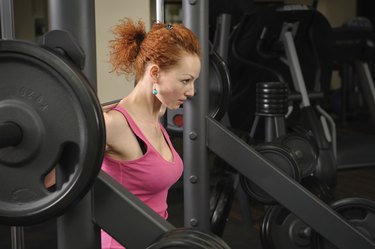
The squat is a multi-joint exercise that recruits multiple muscles in the lower body, making it one of the most frequently used exercises for strength and conditioning. Understanding the complex biomechanics and coordinated muscle actions involved in squatting can help you maximize your training benefits and minimize your risk of injury.
Concentric and Eccentric Muscle Actions
Video of the Day
When squatting, your muscle actions occur in two phases. During the concentric, or shortening, phase enough force is generated by your muscles to overcome opposing forces and produce movement. During the eccentric phase, muscle tension is present, but at a lesser magnitude than the opposing forces as your muscles lengthen. A third action, isometric contraction, occurs when muscle tension is present but the muscles do not change length. When planning training programs, much attention is focused on the concentric phase of exercise. But in compound exercises like squats that involve multiple joints and muscles, a great deal of work is done eccentrically as the muscles lengthen to provide a braking mechanism that slows the rate of movement and protects the body against injury.
Video of the Day
Muscles Involved in Squatting
Many large and small muscles of the lower body come into play during both the upward and downward phases of a squat. Active muscles include the quadriceps, hamstrings, gluteus maximus, gastrocnemius and soleus muscles of the calf, posterior tibialis of the lower leg and foot, and numerous smaller muscles in the foot and ankle. Because it recruits so many muscles in a single maneuver in a way that is functional for activities of daily living, the squat is considered one of the best exercises for improving quality of life.
Downward Phase Muscle Actions
During the downward phase of a squat, gravity provides a powerful downward force. If you are loaded with weights, the force of gravity is magnified. In order to counteract the force of gravity and protect your joints from injury, your gluteus maximus and hamstring muscles work eccentrically at the hip, your quadriceps work eccentrically at the knee, and your calf muscles, ankle flexors and posterior tibialis work eccentrically at the ankle. As these muscles lengthen, they provide balanced tension to control the speed and range of motion of your descent.
Upward Phase Muscle Actions
In the upward phase of a squat, the same muscles that lengthened in the downward phase are activated concentrically to provide force for upward momentum against the force of gravity. Their rate of activation is coordinated to maintain optimal joint angles, and to prevent injury from lateral or medial rotation of the lower extremities. Because the gluteus maximus and hamstring muscles originate on the pelvis, the abdominal and erector spinae muscles of the trunk produce an isometric counter-tension to stabilize the pelvis and hold the trunk in place.
- Fitness Institute Australia: Barbell Squat
- Journal of Strength and Conditioning Research: Squatting Kinematics and Kinetics and Their Relation to Exercise Performance
- MuscleandMotion.com: Anatomy of a Squat
- University of New Mexico: Eccentric Exercie: A Comprehensive Review of a Distinctive Training Method